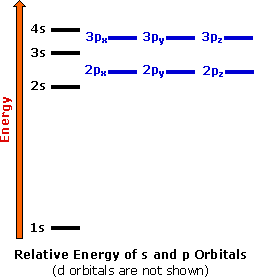Four elements, hydrogen, carbon, oxygen and nitrogen, are the major components of most organic compounds. Consequently, our understanding of organic chemistry must have, as a foundation, an appreciation of the electronic structure and properties of these elements. The truncated periodic table shown above provides the orbital electronic structure for the first eighteen elements (hydrogen through argon). According to the Aufbau principle, the electrons of an atom occupy quantum levels or orbitals starting from the lowest energy level, and proceeding to the highest, with each orbital holding a maximum of two paired electrons (opposite spins).
Electron shell #1 has the lowest energy and its s-orbital is the first to be filled. Shell #2 has four higher energy orbitals, the 2s-orbital being lower in energy than the three 2p-orbitals. (x, y & z). As we progress from lithium (atomic number=3) to neon (atomic number=10) across the second row or period of the table, all these atoms start with a filled 1s-orbital, and the 2s-orbital is occupied with an electron pair before the 2p-orbitals are filled. In the third period of the table, the atoms all have a neon-like core of 10 electrons, and shell #3 is occupied progressively with eight electrons, starting with the 3s-orbital. The highest occupied electron shell is called the valence shell, and the electrons occupying this shell are called valence electrons.
The chemical properties of the elements reflect their electron configurations. For example, helium, neon and argon are exceptionally stable and unreactive monoatomic gases. Helium is unique since its valence shell consists of a single s-orbital. The other members of group 8 have a characteristic valence shell electron octet (ns2 + npx2 + npy2 + npz2). This group of inert (or noble) gases also includes krypton (Kr: 4s2, 4p6), xenon (Xe: 5s2, 5p6) and radon (Rn: 6s2, 6p6). In the periodic table above these elements are colored beige.
The halogens (F, Cl, Br etc.) are one electron short of a valence shell octet, and are among the most reactive of the elements (they are colored red in this periodic table). In their chemical reactions halogen atoms achieve a valence shell octet by capturing or borrowing the eighth electron from another atom or molecule. The alkali metals Li, Na, K etc. (colored violet above) are also exceptionally reactive, but for the opposite reason. These atoms have only one electron in the valence shell, and on losing this electron arrive at the lower shell valence octet. As a consequence of this electron loss, these elements are commonly encountered as cations (positively charged atoms).
The elements in groups 2 through 7 all exhibit characteristic reactivities and bonding patterns that can in large part be rationalized by their electron configurations. It should be noted that hydrogen is unique. Its location in the periodic table should not suggest a kinship to the chemistry of the alkali metals, and its role in the structure and properties of organic compounds is unlike that of any other element.
الأحد، 2 سبتمبر 2012
Electron Configurations of atoms.
الاشتراك في:
تعليقات الرسالة (Atom)

ليست هناك تعليقات:
إرسال تعليق